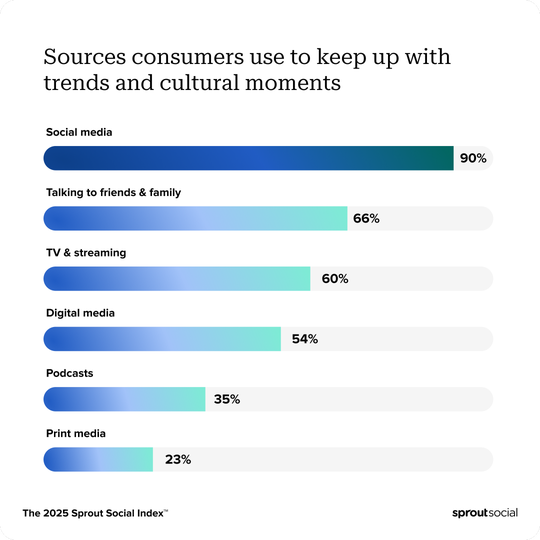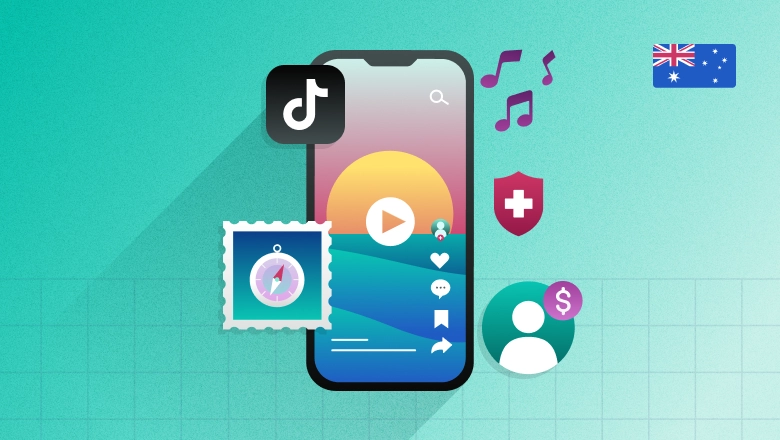Social Media Statistics
80+ Must-know social media marketing statistics for 2025
Discover the latest social media statistics to refine your strategy, uncover new opportunities and stay ahead in 2025.
Want deeper insights into content performance? Our Content Benchmarks Report analyzes 2.1 billion messages to help you understand what works across platforms.
Reading time 10 minutes
Published on February 20, 2025
Table of Contents
Summary
- In 2025, there are estimated to be 5.42 billion total social media users worldwide, with an average person using 6.83 different social networks per month.
- Social media advertising spend is projected to reach $276.7 billion in 2025, with 83% of that ad spend total generated on mobile by 2030.
- Video content continues to be popular, with 78% of people preferring to learn about new products through short video content and 93% of marketers reporting they'll spend more time on social marketing in 2025.
Social media went through a monumental shift in 2024.
AI-generated content flooded feeds, engagement became harder to earn and algorithms started favoring interactions over reach.
In 2025, the shift will be even bigger.
Audiences will demand more authenticity. Platforms will double down on real conversations. And brands that fail to adapt will struggle to scale their engagement and growth. The marketers who win won’t be the ones posting the most, but the ones making data-driven decisions.
Knowing platform-specific demographics and usage patterns as well as the overall state of the industry can help you tailor your social media marketing strategy to boost engagement and ROI.
Let’s look at the top social media statistics to guide your presence in 2025.
Social media usage statistics
We all know social media is ingrained in daily life, but how people use it is changing. While growth may seem slow, that’s only because most of the world is already online.
Here’s a quick snapshot of the top social media demographics and usage stats.
- In 2025, there are estimated to be 5.42 billion total social media users worldwide.
- The average person uses 6.83 different social networks per month.
- Nearly half (48%) of consumers said they interact with brands more often on social media than six months ago.
- Ninety percent of consumers rely on social media to keep up with trends and cultural moments.

- The amount of time internet users spend on social media declined slightly to 141 minutes per day.
With users juggling nearly seven platforms a month, brands can’t afford a single-channel approach. A tailored presence on multiple social networks is key to maximizing reach and engagement across the board. While much of the following content is globally applicable, delving into our UK social media statistics can provide valuable insights if you’re targeting that market, thanks to unique cultural nuances.
Social media advertising statistics and ROI
Social media advertising is no longer a backup plan – it’s crucial for visibility. Paid ads now dominate social feeds, driving brand awareness, sales and engagement.
Learn more about social advertising and ROI stats to inform your strategy.
- Total spend on social media advertising is projected to reach $276.7 billion in 2025.
- It’s now projected that 83% of total social media ad spending will be generated through mobile by 2030.
- Social media ads are the leading source of brand awareness among internet users aged 16 to 34.
- Ad spending on social media is expected to grow by 9.37% each year from 2025 to 2030.
- Social media ads account for 3 in every 10 dollars spent on digital advertising.
- Marketers spend an average of $46.47 per user to reach social audiences.
As more businesses invest in ads, competition is increasing. Brands that want strong ROI will need to work harder. Prioritizing audience targeting, creativity and strategic budgeting will separate winners from those just burning through ad dollars.
Facebook statistics
Whether or not brands should focus on Facebook is a tough question that really depends on your individual Facebook metrics. But the platform’s near-universal adoption, strong marketing appeal and ability to drive direct purchases remains unmatched.
The following Facebook statistics can clue you in further.
- Ninety percent of consumers maintain a profile on Facebook.
- Facebook is the largest social network in the world with roughly 3.065 billion monthly active users.
- Facebook is the most-used platform by marketers worldwide (86%). Instagram sits in second place (79%).
- Facebook’s biggest user group is males aged 25–34, accounting for 18.4% of its global audience, with males aged 18–24 ranking second (13.5%). Female audiences aged 25–34 are the third largest demographic using Facebook.

- Facebook is the top platform for direct purchases, with 39% of consumers turning to it when they’re ready to buy. TikTok (36%) and Instagram (29%) follow closely behind.
- The average American spends about 32 minutes per day on Facebook.
- The platform’s aging demographic means marketers targeting decision-makers and high-income consumers should take full advantage. A mix of paid advertising, groups and community-driven content is the best way to stay relevant on Facebook.
Instagram statistics
While Instagram remains a top destination for product discovery, its overall engagement rate has dropped. At the same time, younger users increasingly rely on Instagram for customer service interactions, showing a shift toward more functional use.
Below are the top social media statistics for Instagram.
- Instagram has 2 billion monthly active users.
- About 82% of social users have profiles on Instagram, second only to Facebook (90%).
- As of January 2025, 28.3% of US Instagram users are between 25 and 34 years old.
- Globally, Instagram users mostly identify as male.
- US adults spend an average of 32 minutes per day on Instagram.

- Instagram offers a total potential ad reach of 1.74 billion users.
- Sixty-nine percent of social users say they see the most engaging brand content on Instagram, and 44% wish brands used Instagram more often..
- Instagram is the top channel for product discovery, with 61% using it to find their next purchase.
- Seventy-two percent of Gen Z users prefer Instagram for customer care over any other channel.
- Instagram’s engagement rate dropped by 28% YoY to 0.50% (from 0.70%), which is still more than three times higher than Facebook (0.15%).
Brands on Instagram should focus more on ecommerce features, quick-response messaging and interactive formats like Stories and Reels. Engagement might be dipping, but those who adapt their Instagram strategy can still tap into its high-value audience.
LinkedIn statistics
LinkedIn continues to grow as the go-to platform for professionals and B2B marketing. With a high concentration of decision-makers and business leaders, it remains an ideal space for thought leadership and lead generation.
Here are some LinkedIn statistics you should know.
- There are more than more than 1 billion members across 200 countries on LinkedIn.
- Forty-three percent of all social users have a LinkedIn profile.
- The United States has the highest user rate in the world on LinkedIn with an audience reach of over 234 million users.
- There are over 67 million company profiles on LinkedIn.
- 50.6% of worldwide users are between ages 25 and 34 years old, far exceeding any other age group.

- A quarter of LinkedIn users engage with brand content daily (or more).
- Text posts and static images drive the most engagement on LinkedIn.
Spurred by the widespread career changes over the past few years, the platform doesn’t look to slow down any time soon. Brands targeting young professionals should prioritize high-quality content, industry insights and personal branding in their LinkedIn marketing.
Pinterest statistics
Pinterest is often underestimated, yet it consistently delivers diverse, high-intent users who are actively searching for products and brands.
Here are some top Pinterest statistics to look out for.
- Pinterest has around 553 million monthly active users.
- Around 69.4% of Pinterest users identify as female, while 22.6% identify as male and 8% are of unspecified gender.
- In March 2024, Pinterest.com received around 1.3 billion visits, making it one of the most-visited websites on the internet.

- Pinterest is the second-most visited social media website in the US.
- About 80% of weekly users have found a new brand or product on the platform.
- A quarter (25%) of all social media users wish more brands used Pinterest, with this number rising to 31% among Gen Z.
Consumers want to see more brand content on Pinterest, which means there’s a huge opportunity for marketers to invest in SEO-driven Pins, Pinterest advertising to capture an engaged audience ready to buy.
Reddit statistics
Reddit’s growth trajectory and increasing ad revenue marks its value as a niche marketing goldmine. Let’s look at the top Reddit statistics marketers need to know.
- There are estimated to be 49 million Reddit users in 2025, with this number expected to grow to 556.59 million in 2028.
- As of Q3 2024, 59.8% of Reddit users identify as male, while users who identify as women make up approximately 39.1%.

- Reddit generated $315 million USD in advertising revenue in Q3 2024, marking a 56% increase from the previous year.
- In January 2025 alone, Reddit was visited 3.8 billion times from desktop and mobile.
- More than 50% of Reddit’s website traffic comes from the United States.
- As of February 2024, r/funny was Reddit’s largest community with 56.6 million subscribers, followed by r/AskReddit with 45 million members.
The platform’s users demand authenticity and real conversations rather than promotional content. Brands must practice Reddit social listening, contribute meaningfully to discussions and avoid anything that feels like a hard sell.
Threads statistics
Threads is still finding its place, but its growth proves that users are interested in a new kind of text-based social experience. Here are some Threads statistics to be aware of.
- By Q4 2024, Threads reached 275 million monthly active users, rising from 200 million in the third quarter.
- Users spend an average of 3 minutes and 51 seconds on the website per visit.
- More than half of Threads users are male, while the dominating age group on the site is 25-34 year olds.
Meta’s newest platform is attracting users who engage in short, casual discussions rather than algorithm-driven content. Brands that experiment with Threads now can carve out a strong presence before competition intensifies.
TikTok statistics
TikTok isn’t slowing down. Even with bans and regulatory hurdles, people are still spending hours on the platform. Beyond watching entertaining videos, TikTok users are actively searching for, shopping and interacting with brands more than ever.
Here are some useful TikTok statistics to keep in mind.
- As of January 2025, TikTok receives around 2.65 billion monthly visits.
- TikTok offers a potential advertising reach of 1.59 billion users.
- Around 56% of social users have a TikTok profile, rising to 82% for Gen Z.
- Android phone users worldwide spend an average of 35 hours per month watching TikTok videos.
- As of February 2025, TikTok’s global user base skews male, with 55.7% of users identifying as men (based on available gender data.)
- As of February 2025, 35.3% of TikTok users are 25-34 years old, the largest age group on the platform, followed by users aged 18-24 years old (30.7%).
- TikTok is the top platform for product discovery among Gen Z.

- Over half (54%) of TikTok users engage with brand content daily on the platform.
TikTok isn’t just for “young people” anymore. Gen Z is getting older and still using the platform in full force, even as a search engine. The brands winning here aren’t overthinking it. They’re jumping on trends, creating content that feels real and letting creators take the lead. For a deeper dive into another platform popular with younger demographics, explore our latest Snapchat statistics.
If you’re already on the platform, make sure to watch your TikTok analytics and how to reach your audience.
X (formerly Twitter) statistics
X, previously known as Twitter, remains a go-to platform for real-time discussions, news, memes and customer service. While some advertisers have pulled back, user activity remains strong, particularly for those seeking updates and fast-paced interactions.
Take a look at the Twitter statistics below to understand more about marketing on the platform.
- X has about 611 million monthly active users in total worldwide.
- Half of all social users have a profile on X.
- In 2024, X recorded around 364 billion total user active seconds and 8.3 billion video views on a daily basis.

- More than half (60.3%) of X users are men (based on available gender data).
- In 2024, 59% of X users used the platform to get the latest news.
Even as user preferences shift, the platform appears to be growing, so marketers may not want to count it out yet. The brands that thrive here are actively engaging in trending topics, responding quickly and maintaining a strong brand voice.
YouTube statistics
YouTube is still the top platform for video content, outpacing competitors in watch time and engagement. Here are the top YouTube statistics to know about.
- As of April 2024, YouTube has nearly 2.5 billion users worldwide.
- Around 78% of all social users own a YouTube account.
- As of February 2025, YouTube’s biggest gender segments are males aged between 25-34 (12%), and males aged between 35-44 (10.1%). Audiences who identify as female in the same age groups are around 9.7% and 8.4%, respectfully.
- More people spend time on YouTube than on any other social platform. In fact, users spend almost twice as much time on YouTube than on its next nearest rival, TikTok.
- About 70.29% of all visits to YouTube come from a mobile device.
- Over half of YouTube users prefer long-form brand videos, while 31-60 second videos are their second choice.
While short-form videos are growing, long-form content still holds strong on YouTube, showing that users want both quick entertainment and in-depth insights. Use both formats as part of your YouTube marketing strategy to maximize audience retention and discoverability.
Social media video statistics
Video continues to be an all-time favorite content type. It’s versatile, engaging and offers excellent ROI to marketers worldwide. Let’s look at some recent social media video statistics.
- Around 78% of people prefer to learn about a new product or service via short video content.

- Around 93% of marketers plan to spend the same or more on video marketing in 2025.
- Marketers say video has helped them improve user understanding of products or services (99%), increase brand awareness (96%), generate leads (88%) and boost website traffic (82%).
- The global digital video advertising market is expected to grow from $104.65 billion in 2024 to $140.18 billion in 2025.
Marketers need to focus on snackable, mobile-friendly video formats like Reels, TikTok and YouTube Shorts. More importantly, brands need to find ways to create videos that entertain, educate or inspire in under 30 seconds.
Influencer marketing statistics
Working with influencers is one of the best inbound marketing strategies being used today. More than ever, consumers are making purchase decisions based on influencer content.
Here are some influencer marketing statistics about which platforms marketers are leveraging, what they’re hoping to achieve and how they plan to execute influencer marketing in the future.
- The total influencer marketing market size is expected to grow to $32.55 billion in 2025, up from $24 billion in 2024.
- Instagram is the most preferred influencer marketing channel, with 57.1% of marketers using it to partner with creators. TikTok (51.6%) follows closely behind.
- Nearly half of all consumers (49%) make purchases at least once a month because of influencer content.
- About 66.4% of marketers found that using AI improved the performance of their influencer marketing campaigns.

- Around 93% of influencers say the quality of a brand’s existing social content affects their decision to collaborate.
To maximize impact, brands should prioritize creators who align with their values and have strong connections with their audience rather than wide reach.
The key is to pick the best platforms and influencers for your brand, both of which can be automated using the right influencer marketing tools.
Consumer behavior statistics
The concept of buying something you saw on social media is not new. From product recommendations to first impressions from brands, the impact of social media on consumers is well-documented. Learn more from these consumer behavior statistics.
- Facebook (40%) and YouTube (32%) are the top social media platforms consumers use for reading reviews.
- Nearly 56% of online adults make online purchases on a weekly basis.
- Roughly 81% of consumers say social media compels them to make spontaneous purchases multiple times per year or more, with 28% making impulse purchases once a month.
- Around 73% of social users agree if a brand doesn’t respond on social, they’ll buy from a competitor.
- Nearly three-quarters of consumers expect a response within 24 hours or sooner, which is consistent with our data collected in 2022 and 2023.
Trust plays a huge role in buying decisions. People want social proof, fast customer service and transparent communication. Brands that engage, respond quickly and create genuine, user-generated content will earn loyalty.
Use social media statistics to guide your strategy
Keeping up with the latest social media marketing statistics helps you refine your strategy and set smarter goals.
Are there emerging platforms worth exploring? Is it time to adjust your balance between organic content and paid ads? Should you double down on what’s already working?
These insights can help you find the answers. Taking the time to analyze them is worth it – bookmark this page if you haven’t already.
For more guidance, check out our social media management guide to build a strategy that keeps you ahead in 2025.
Social Media Statistics FAQ
What is the most used social media platform?
The most-used social media platform is Facebook with over 3 billion monthly active users. Facebook is followed by YouTube (2.5 billion users), Instagram and WhatsApp (tied at 2 billion monthly active users).
Is social media use increasing?
While time spent on social media has decreased slightly by a few minutes, the number of social media users globally continues to rise. As of January 2025, 206 million new users have joined social media since this time last year.
Is social media marketing still effective?
Yes! There are over 5.2 billion social media user identities, meaning 63.9% of the population has created at least one social media account. That’s a massive potential reach. As long as you create the right strategy and target the right people, you should see success with social media marketing.
Additional resources for Social Media Statistics
Understanding social media demographics in the UK: age, gender & behaviour
2025 TikTok UK statistics: Growth, demographics & engagement
Snapchat statistics for 2025: Usage & trends
Australian social media demographics to inform your strategy
Australian TikTok statistics to inform your strategy in 2025
Reddit statistics in 2025 and tactics to grow your brand
28 LinkedIn statistics that marketers must know in 2025
25 must-know Pinterest stats for marketers in 2025
25 YouTube stats marketers should know in 2025 [Updated]
28 TikTok statistics marketers need to know in 2025
45+ Twitter (X) stats to know in marketing in 2025
10 Australian social media trends for 2025
Social media statistics shaping Australia’s digital landscape in 2025
Social media statistics in the UK: What businesses need to know in 2025
Social media demographics to inform your 2025 strategy
26 Instagram stats you need to know for 2025
80+ Must-know social media marketing statistics for 2025
31 Facebook statistics marketers should know in 2025
60+ social media video statistics marketers need to know in 2025


















Share